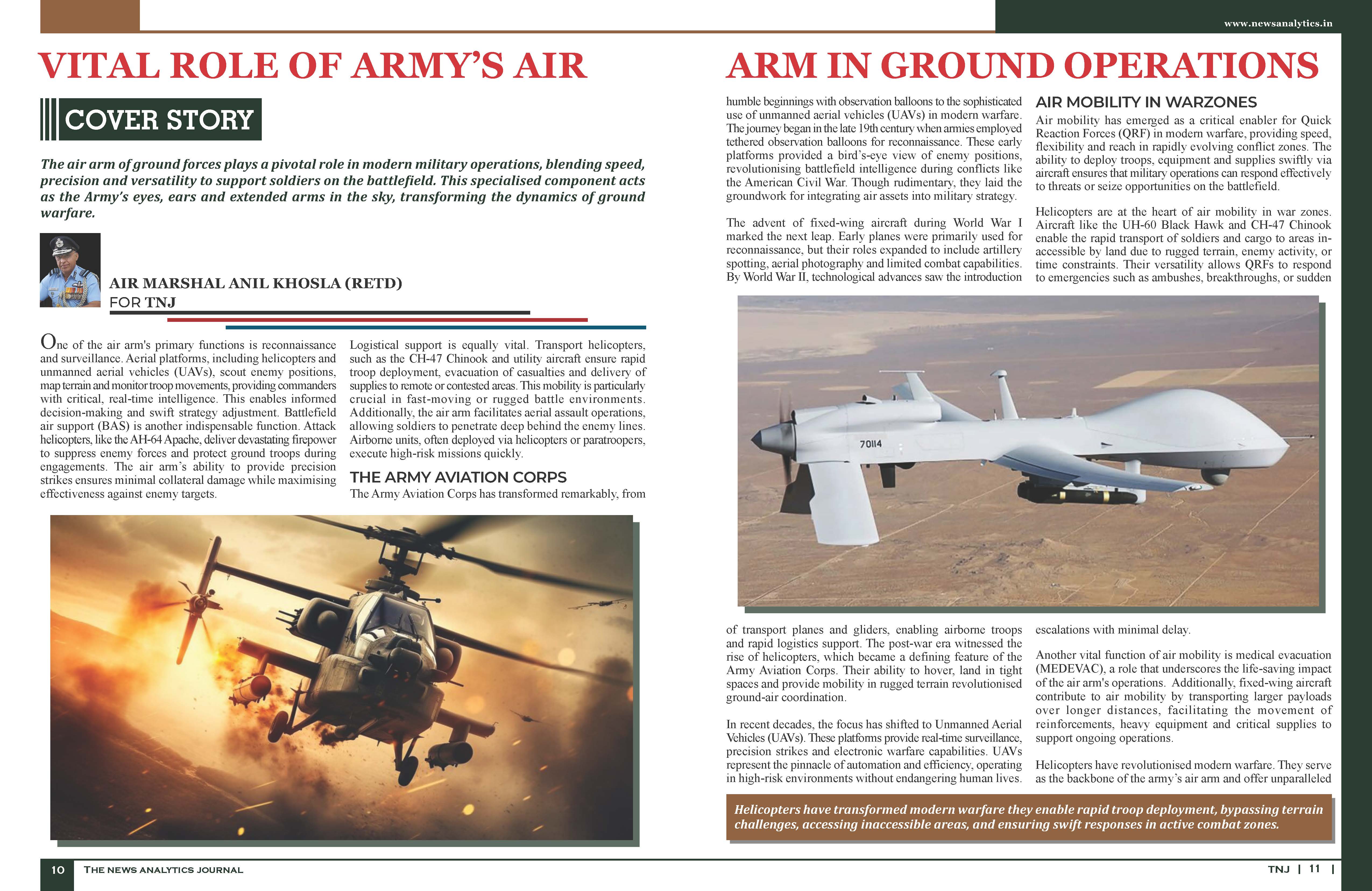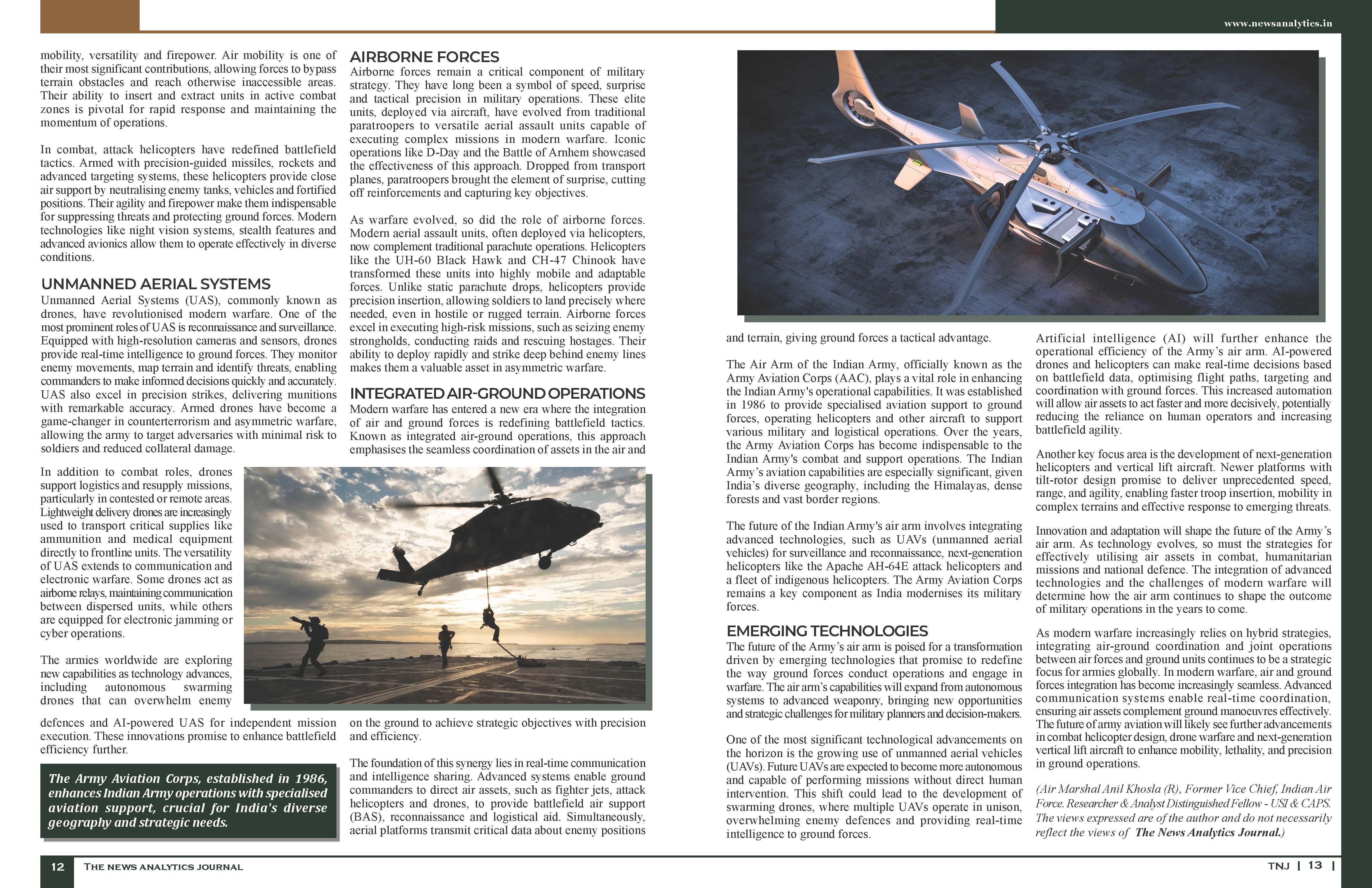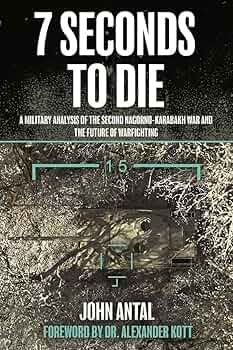

My article published in the News Analytics Journal in the Jan 25 issue.
The air arm of ground forces plays a pivotal role in modern military operations, blending speed, precision, and versatility to support soldiers on the battlefield. This specialised component acts as the army’s eyes, ears, and extended arms in the skies, transforming the dynamics of ground warfare.
Roles and Functions.
One of the air arm’s primary functions is reconnaissance and surveillance. Aerial platforms, including helicopters and unmanned aerial vehicles (UAVs), scout enemy positions, map terrain, and monitor troop movements, providing commanders with critical, real-time intelligence. This enables informed decision-making and swift strategy adjustment.
Battlefield air support (BAS) is another indispensable function. Attack helicopters, like the AH-64 Apache, deliver devastating firepower to suppress enemy forces and protect ground troops during engagements. The air arm’s ability to provide precision strikes ensures minimal collateral damage while maximising effectiveness against enemy targets.
Logistical support is equally vital. Transport helicopters, such as the CH-47 Chinook, and utility aircraft ensure rapid troop deployment, evacuation of casualties, and delivery of supplies to remote or contested areas. This mobility is particularly crucial in fast-moving or rugged battle environments.
Additionally, the air arm facilitates aerial assault operations, allowing soldiers to penetrate deep behind enemy lines. Airborne units, often deployed via helicopters or paratroopers, execute high-risk missions quickly.
Evolution of the Army Aviation Corps: From Observation Balloons to Modern-Day UAVs
The Army Aviation Corps has transformed remarkably, from humble beginnings with observation balloons to the sophisticated use of unmanned aerial vehicles (UAVs) in modern warfare. The journey began in the late 19th century when armies employed tethered observation balloons for reconnaissance. These early platforms provided a bird’s-eye view of enemy positions, revolutionising battlefield intelligence during conflicts like the American Civil War. Though rudimentary, they laid the groundwork for integrating air assets into military strategy.
The advent of fixed-wing aircraft during World War I marked the next leap. Early planes were primarily used for reconnaissance, but their roles expanded to include artillery spotting, aerial photography, and limited combat capabilities. By World War II, technological advances saw the introduction of transport planes and gliders, enabling airborne troops and rapid logistics support. The post-war era witnessed the rise of helicopters, which became a defining feature of the Army Aviation Corps. Their ability to hover, land in tight spaces, and provide mobility in rugged terrain revolutionised ground-air coordination.
In recent decades, the focus has shifted to Unmanned Aerial Vehicles (UAVs). These platforms provide real-time surveillance, precision strikes, and electronic warfare capabilities. UAVs represent the pinnacle of automation and efficiency, operating in high-risk environments without endangering human lives.
Air Mobility in Warzones: The Key to Quick Reaction Forces
Air mobility has emerged as a critical enabler for Quick Reaction Forces (QRF) in modern warfare, providing speed, flexibility, and reach in rapidly evolving conflict zones. The ability to deploy troops, equipment, and supplies swiftly via aircraft ensures that military operations can respond effectively to threats or seize opportunities on the battlefield.
Helicopters are at the heart of air mobility in war zones. Aircraft like the UH-60 Black Hawk and CH-47 Chinook enable the rapid transport of soldiers and cargo to areas inaccessible by land due to rugged terrain, enemy activity, or time constraints. Their versatility allows QRFs to respond to emergencies such as ambushes, breakthroughs, or sudden escalations with minimal delay.
Another vital function of air mobility is medical evacuation (MEDEVAC), a role that underscores the life-saving impact of the air arm’s operations. In warzones, helicopters equipped with medical facilities extract wounded personnel from the battlefield, often saving lives by providing care within the critical ‘golden hour.’ Additionally, fixed-wing aircraft contribute to air mobility by transporting larger payloads over longer distances, facilitating the movement of reinforcements, heavy equipment, and critical supplies to support ongoing operations.
Helicopters in Combat: The Backbone of the Army’s Air Arm
Helicopters have revolutionised modern warfare. They serve as the backbone of the army’s air arm and offer unparalleled mobility, versatility, and firepower. Their adaptability allows them to serve in various roles, from swift troop deployments to battlefield air support, ensuring operational success in dynamic combat environments.
Air mobility is one of their most significant contributions, allowing forces to bypass terrain obstacles and reach otherwise inaccessible areas. Their ability to insert and extract units in active combat zones is pivotal for rapid response and maintaining the momentum of operations.
In combat, attack helicopters have redefined battlefield tactics. Armed with precision-guided missiles, rockets, and advanced targeting systems, these helicopters provide close air support by neutralising enemy tanks, vehicles, and fortified positions. Their agility and firepower make them indispensable for suppressing threats and protecting ground forces.
Modern technological advancements have further enhanced combat helicopters’ capabilities. Night vision systems, stealth features, and advanced avionics allow them to operate effectively in diverse conditions, from deserts to dense urban landscapes.
Unmanned Aerial Systems (UAS): Expanding the Army’s Air Arm
Unmanned Aerial Systems (UAS), commonly known as drones, have revolutionised modern warfare, becoming an indispensable part of the army’s air arm. Their ability to operate without a human pilot on board, combined with advanced technology, has significantly expanded the army’s operational capabilities.
One of the most prominent roles of UAS is reconnaissance and surveillance. Equipped with high-resolution cameras and sensors, drones provide real-time intelligence to ground forces. They monitor enemy movements, map terrain, and identify threats, enabling commanders to make informed decisions quickly and accurately. UAS also excel in precision strikes, delivering munitions with remarkable accuracy. Armed drones have become a game-changer in counterterrorism and asymmetric warfare, allowing the army to target adversaries with minimal risk to soldiers and reduced collateral damage.
In addition to combat roles, drones support logistics and resupply missions, particularly in contested or remote areas. Lightweight delivery drones are increasingly used to transport critical supplies like ammunition and medical equipment directly to frontline units. The versatility of UAS extends to communication and electronic warfare. Some drones act as airborne relays, maintaining communication between dispersed units, while others are equipped for electronic jamming or cyber operations.
The armies worldwide are exploring new capabilities as technology advances, including autonomous swarming drones that can overwhelm enemy defences and AI-powered UAS for independent mission execution. These innovations promise to enhance battlefield efficiency further.
Airborne Forces: From Paratroopers to Aerial Assault Units
Airborne forces remain a critical component of military strategy. They have long been a symbol of speed, surprise, and tactical precision in military operations. These elite units, deployed via aircraft, have evolved from traditional paratroopers to versatile aerial assault units capable of executing complex missions in modern warfare.
The origins of airborne forces date back to World War II when paratroopers were first used to disrupt enemy defences by landing behind their lines. Iconic operations like D-Day and the Battle of Arnhem showcased the effectiveness of this approach. Dropped from transport planes, paratroopers brought the element of surprise, cutting off reinforcements and capturing key objectives.
As warfare evolved, so did the role of airborne forces. Modern aerial assault units, often deployed via helicopters, now complement traditional parachute operations. Helicopters like the UH-60 Black Hawk and CH-47 Chinook have transformed these units into highly mobile and adaptable forces. Unlike static parachute drops, helicopters provide precision insertion, allowing soldiers to land precisely where needed, even in hostile or rugged terrain.
Airborne forces excel in executing high-risk missions, such as seizing enemy strongholds, conducting raids, and rescuing hostages. Their ability to deploy rapidly and strike deep behind enemy lines makes them a valuable asset in asymmetric warfare. Advances in technology, such as improved navigation systems and night vision equipment, have further enhanced their effectiveness.
Integrated Air-Ground Operations: A New Era in Combined Arms Tactics
Modern warfare has entered a new era where the integration of air and ground forces is redefining battlefield tactics. Known as integrated air-ground operations, this approach emphasises the seamless coordination of assets in the air and on the ground to achieve strategic objectives with precision and efficiency.
The foundation of this synergy lies in real-time communication and intelligence sharing. Advanced systems enable ground commanders to direct air assets, such as fighter jets, attack helicopters, and drones, to provide battlefield air support (BAS), reconnaissance, and logistical aid. Simultaneously, aerial platforms transmit critical data about enemy positions and terrain, giving ground forces a tactical advantage.
The success of these operations depends on joint planning, extensive training, interoperable equipment, and shared strategic objectives. Integrated air-ground tactics have transformed warfare, ensuring that armies can operate as unified, adaptive forces capable of dominating complex and dynamic battlefields.
Air Arm of the Indian Army
The Air Arm of the Indian Army, officially known as the Army Aviation Corps (AAC), plays a vital role in enhancing the Indian Army’s operational capabilities. It was established in 1986 to provide specialised aviation support to ground forces, operating helicopters and other aircraft to support various military and logistical operations. Over the years, the Army Aviation Corps has become indispensable to the Indian Army’s combat and support operations.
The Indian Army’s aviation capabilities are especially significant given India’s diverse geography, including the Himalayas, dense forests, and vast border regions. The ability to swiftly deploy troops and supplies via air ensures that the army can maintain high operational readiness, even in areas with limited infrastructure.
The future of the Indian Army’s air arm involves integrating advanced technologies, such as UAVs (unmanned aerial vehicles) for surveillance and reconnaissance, next-generation helicopters like the Apache AH-64E attack helicopters, and a fleet of indigenous helicopters.
The Army Aviation Corps remains a key component as India modernises its military forces. It ensures rapid reaction and mobility for ground forces and significantly enhances India’s strategic defence capabilities.
The Future of the Army’s Air Arm: Emerging Technologies and Strategic Challenges
The future of the Army’s air arm is poised for a transformation driven by emerging technologies that promise to redefine the way ground forces conduct operations and engage in warfare. The air arm’s capabilities will expand from autonomous systems to advanced weaponry, bringing new opportunities and strategic challenges for military planners and decision-makers.
One of the most significant technological advancements on the horizon is the growing use of unmanned aerial vehicles (UAVs). These systems offer several advantages, including reduced risk to personnel, long endurance surveillance, and the ability to strike targets with precision. Future UAVs are expected to become more autonomous and capable of performing missions without direct human intervention. This shift could lead to the development of swarming drones, where multiple UAVs operate in unison, overwhelming enemy defences and providing real-time intelligence to ground forces.
Artificial intelligence (AI) will further enhance the operational efficiency of the Army’s air arm. AI-powered drones and helicopters can make real-time decisions based on battlefield data, optimising flight paths, targeting, and coordination with ground forces. This increased automation will allow air assets to act faster and more decisively, potentially reducing the reliance on human operators and increasing battlefield agility.
Another key focus area is the development of next-generation helicopters and vertical lift aircraft. Newer platforms with tilt-rotor design promise to deliver unprecedented speed, range, and agility, enabling faster troop insertion, mobility in complex terrains, and effective response to emerging threats.
Innovation and adaptation will shape the future of the Army’s air arm. As technology evolves, so must the strategies for effectively utilising air assets in combat, humanitarian missions, and national defence. The integration of advanced technologies and the challenges of modern warfare will determine how the air arm continues to shape the outcome of military operations in the years to come.
Conclusion. The air arm is not just a support element but a force multiplier, bridging the gap between land and air operations. Its unmatched ability to provide reconnaissance, firepower, and mobility ensures ground forces maintain their tactical edge, making it an indispensable component of today’s armies. As modern warfare increasingly relies on hybrid strategies, integrating air-ground coordination and joint operations between air forces and ground units continues to be a strategic focus for armies globally. In modern warfare, air and ground forces integration has become increasingly seamless. Advanced communication systems enable real-time coordination, ensuring air assets complement ground manoeuvres effectively. The future of army aviation will likely see further advancements in combat helicopter design, drone warfare, and next-generation vertical lift aircraft to enhance mobility, lethality, and precision in ground operations.
Your valuable comments are most welcome.
For regular updates, please register your email here:-
References and credits
To all the online sites and channels.
References:-
-
- Chhina, Rana T.S. The Indian Army: An Illustrated Overview. Centre for Armed Forces Historical Research, 2005.
-
- Singh, Bikramjeet. “Army Aviation Corps: A Key Element in India’s Operational Strategy.” Indian Defence Review, Vol. 30, Issue 4, 2020.
-
- Joshi, Rajesh. “Transforming Army Aviation: Challenges and Opportunities.” Force Magazine, June 2019.
-
- Nambiar, A.G. “Indian Army Aviation: The Role and Future Prospects.” South Asia Defence and Strategic Review, Vol. 12, Issue 2, 2021.
-
- Indian Army Official Website. “Army Aviation Corps.” https://indianarmy.nic.in.
-
- Press Information Bureau (PIB). “Strengthening Army Aviation with Indigenous Platforms.” Government of India, 2023.
-
- Bharat Rakshak. “History and Evolution of Indian Army Aviation Corps.” http://bharat-rakshak.com.
-
- Pubby, Manu. “Army Aviation Corps Modernization: Induction of ALH Dhruv and Rudra.” Economic Times, 2022.
9. Chant, Christopher. Warfare and the Third Dimension: Aircraft, Rockets, and Missiles. Hamlyn, 1990.
-
- Zaloga, Steven J. Airborne: A Combat History of American Airborne Forces. Stackpole Books, 2010.
11 Singer, P.W. Wired for War: The Robotics Revolution and Conflict in the 21st Century. Penguin Press, 2009.
-
- Gertler, Jeremiah. U.S. Unmanned Aerial Systems. Congressional Research Service, 2012.
-
- Freedman, Lawrence. The Future of War: A History. Public Affairs, 2017.
-
- Kallenborn, Zachary. “The Era of Drone Swarms: What to Expect and How to Counter.” The Modern War Institute at West Point, 2020.
Disclaimer:
Information and data included in the blog are for educational & non-commercial purposes only and have been carefully adapted, excerpted, or edited from reliable and accurate sources. All copyrighted material belongs to respective owners and is provided only for wider dissemination.


